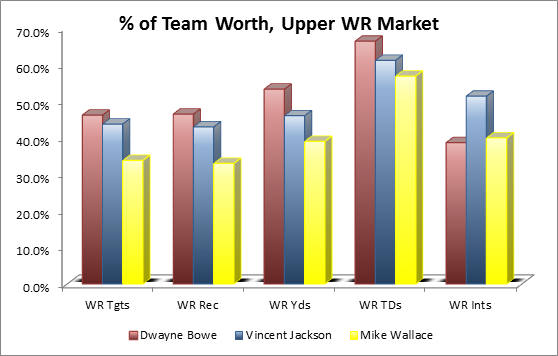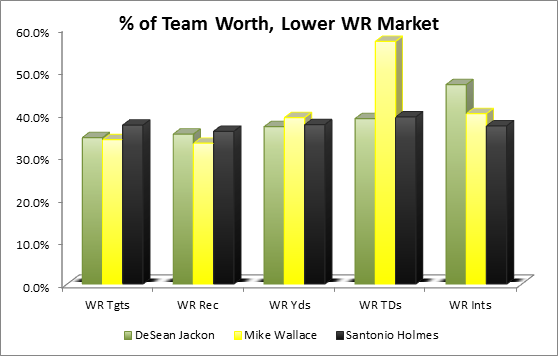[adsenseyu1]
There has been a lot of discussion lately regarding Hakeem Nicks and his level of play in a contract year. Having watched most of his games this season I can understand the negative feelings towards Nicks. He has clearly fallen out of favor with Eli Manning following the emergence of Victor Cruz in 2011 and has become just another secondary target. At times Nicks doesn’t look like he is concentrating leading to what seems to be a large number of drops. But at the end of the day does it really matter?
Nicks, by pretty much all accounts, wanted a new contract this offseason. The Giants at one point made it known that Nicks was more valuable that Cruz, which likely only added more reasons to seek a new deal now. The Giants, who really had limited cap space to work with, preferred to let Nicks play out the contract. Nicks was unhappy and maybe that has carried over to the field. But it’s not like he is the first to do this.
Mike Wallace, now of the Miami Dolphins, sulked through his final year in a Steelers uniform. Wallace was a Restricted Free Agent who had no choice but to play on his tender. Like Nicks, Wallace watched a teammate be signed to a contract extension while this occurred. DeSean Jackson of the Eagles had hoped for a new contract in 2011. It never happened and he was unhappy throughout the 2011 season. He did get a new contract in 2012 with the Eagles.
When you look at some of the big name contracts given out to Wide Receivers in the last two years there has been minimal importance given to the “down season” leading into the new contract. The players I want to look at here are Jackson, Wallace, and Dwayne Bowe. I considered Greg Jennings, but his injury plagued season was so bad I thought that it was unfair to include him.
The following table will include the percentage increase/decrease in a number of key categories from the players “contract season” to the two year prime season. For Nicks we’ll be using the 2010 and 2011 season as he struggled with injuries in 2012. The categories are target per game, yards per game, yards per target, yards per receptions, and catch rates. All raw data used to compile this figures is courtesy Pro Football Focus
| Player | TPG | YPG | YPT | YPR | Catch Rate |
| Wallace | 20.1% | -27.0% | -39.3% | -29.5% | -13.9% |
| Bowe | 3.3% | -15.0% | -17.8% | -10.5% | -8.1% |
| Jackson | -10.0% | -16.5% | -7.2% | -18.0% | 13.2% |
| Nicks | -18.1% | -16.2% | 2.3% | 20.2% | -14.9% |
In terms of yards per target and yards per reception Nicks numbers are actually better than where he was back in 2010 and 2011 when he looked like a can’t miss player. Each of the other players saw dramatic dips in their contract seasons. On a per game basis Nicks is right alongside Bowe and Jackson and significantly ahead of Wallace, who crashed on the Steelers. His reception rate decline is the worst of the group, however, and his targets were way down.
The real important takeaway for a player like Nicks, who used to be a dominant target in the passing game, is that all he has to do is convince one team that the Giants are not featuring him for reasons unknown to him and that it has nothing to do with his play. If he was featured the way he was in the past his numbers would be right on his career averages, which is more than the other three could say at contract time.
The alarming items for Nicks come from two areas. One is drops. Like I said above his drops seem terrible and the stats completely back that up. His fall in that category is unique compared to the others.
| Player | DPT | DPR |
| Wallace | -3.1% | 12.5% |
| Bowe | -20.6% | -13.6% |
| Jackson | 20.8% | 6.7% |
| Nicks | 109.3% | 146.0% |
Nicks is essentially dropping double the amount of passes he did in the past. That should be a red flag to an organization about how distracted he can be once taken out of an offense and a clear indication of a reason why he is not being featured as much in the offense. Nicks does have an injured finger and I am sure they will argue that these numbers are so far above his averages that they are a byproduct of injury, but it would be the one major concern.
The other concern is that you do have to go back, because of injury, two years to hit Nicks’ prime seasons when Eli Manning treated him as a number 1 receiver in an offense. I’m not sure how much weight teams will put on that but it could potentially be an issue.
Again though, all it takes is one team to bite. The Eagles eventually paid Jackson $9.7 million a season, at the time one of the more lucrative contracts at the position. Bowe became the highest receiver not named Calvin or Larry for a few weeks this season before Wallace jumped him with his $12 million a year contract. Whether they are worth it or not is a different debate (Bowe and Wallace are struggling and Jackson is hoping to avoid a re-done contract in 2014), but the seeming lack of production is not something that should compromise his ability to earn a new contract, provided his finishes the year on the same pace. If he can bring his drops down there is little to really point to about his decline.
In some ways it may be better for Nicks to remain on the Giants for the remainder of the season. If he gets traded and fails to perform that could have an impact on him, much more than what is occurring in New York. While I think many positions are capable of transferring offenses in-season I don’t believe wide receiver is one of them. It takes chemistry with your QB to be a top level producer. For whatever reason he doesn’t have that with Eli, but I would think he would have far more chemistry with Eli than with a QB he has never played with before.
Years ago when the Dallas Cowboys traded for Roy Williams of the Lions, Williams was someone with 1,000+ yard talent and an injury history. He was struggling in his contract year and the Cowboys gave up a significant set of draft picks to bring him on the team before the trade deadline. He went from bad to worse in Dallas averaging under 20 yards a game as he struggled to learn the offense. Luckily for Williams, Cowboys owner Jerry Jones blindly gave him a $54 million dollar contract before he ever played a down for Dallas. Had Williams played the season out and failed with the Lions and Cowboys I think his options would have been more limited since you can make an excuse for not being used on one team, but once you get to two teams it starts to look more troublesome.
So if a team is able to pry Nicks away for a minimal haul and fails to extend him then I think his price tag could be damaged. If he keeps doing what he is doing he will have all offseason to convince a number of teams that this one situation was poor in New York and if given the opportunity he’ll be every bit the number 1 receiver most projected him as two years ago.
[subscribe2]


